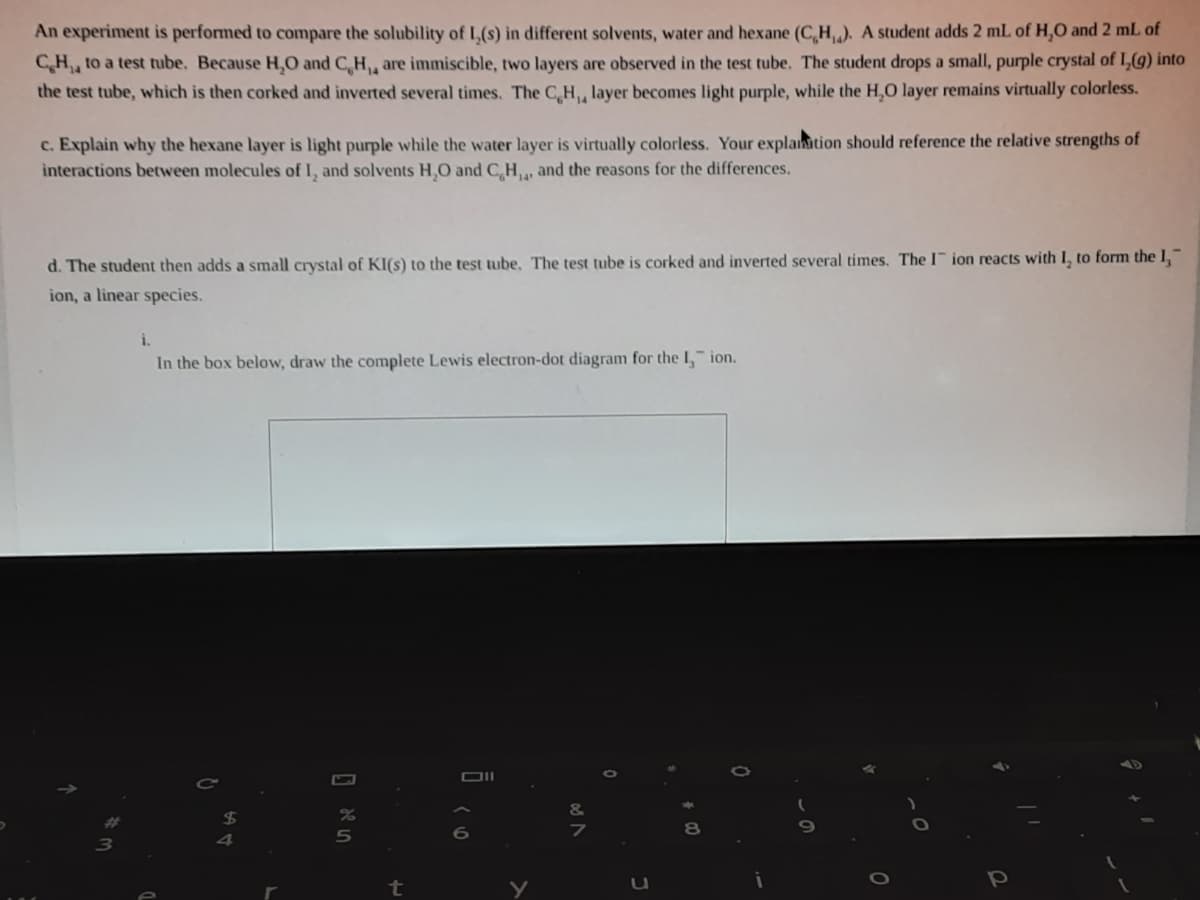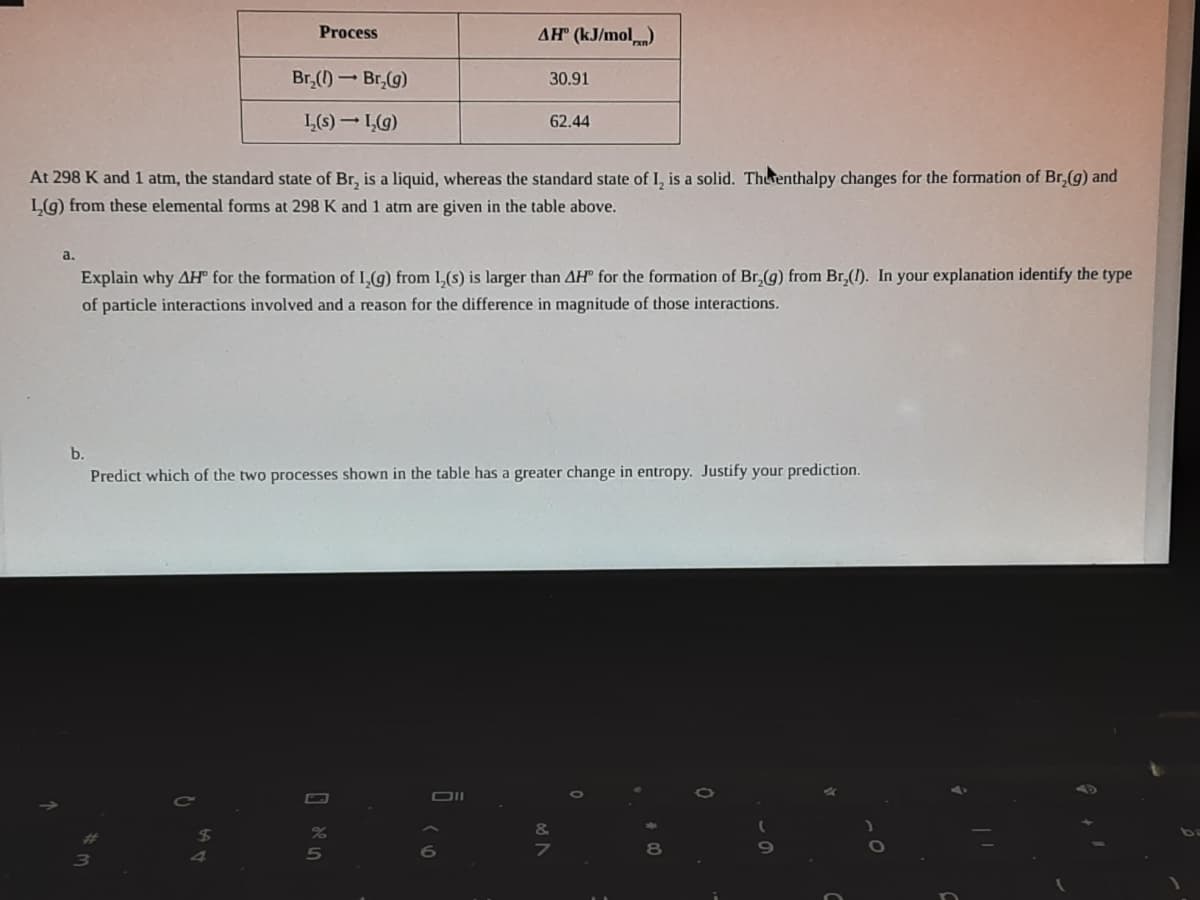At 298 K and 1 atm, the standard state of Br, is a liquid, whereas the standard state of I, is a solid. Theenthalpy changes for the formation of Br,(g) and L(g) from these elemental forms at 298 K and 1 atm are given in the table above. a. Explain why AH for the formation of 1,(g) from L(s) is larger than AH" for the formation of Br,(g) from Br,(1). In your explanation identify the type of particle interactions involved and a reason for the difference in magnitude of those interactions. b. Predict which of the two processes shown in the table has a greater change in entropy. Justify your prediction.
At 298 K and 1 atm, the standard state of Br, is a liquid, whereas the standard state of I, is a solid. Theenthalpy changes for the formation of Br,(g) and L(g) from these elemental forms at 298 K and 1 atm are given in the table above. a. Explain why AH for the formation of 1,(g) from L(s) is larger than AH" for the formation of Br,(g) from Br,(1). In your explanation identify the type of particle interactions involved and a reason for the difference in magnitude of those interactions. b. Predict which of the two processes shown in the table has a greater change in entropy. Justify your prediction.
Principles of Modern Chemistry
8th Edition
ISBN:9781305079113
Author:David W. Oxtoby, H. Pat Gillis, Laurie J. Butler
Publisher:David W. Oxtoby, H. Pat Gillis, Laurie J. Butler
Chapter12: Thermodynamic Processes And Thermochemistry
Section: Chapter Questions
Problem 82AP: Nitromethane, CH3NO2, is a good fuel. It is a liquid at ordinary temperatures. When the liquid is...
Related questions
Question
Please answer parts a, b, and c

Transcribed Image Text:An experiment is performed to compare the solubility of L,(s) in different solvents, water and hexane (C,H,). A student adds 2 mL of H,0 and 2 mL of
CH, to a test tube. Because H,O and C,H, are immiscible, two layers are observed in the test tube. The student drops a small, purple crystal of I,(g) into
the test tube, which is then corked and inverted several tìmes. The C,H, layer becomes light purple, while the H,0 layer remains virtually colorless.
c. Explain why the hexane layer is light purple while the water layer is virtually colorless. Your explation should reference the relative strengths of
interactions between molecules of I, and solvents H,O and C,H, and the reasons for the differences.
d. The student then adds a small crystal of KI(s) to the test tube. The test tube is corked and inverted several times. Ther ion reacts with I, to form the 1,
ion, a linear species.
i.
In the box below, draw the complete Lewis electron-dot diagram for the I, ion.
t

Transcribed Image Text:Process
AH" (kJ/mol)
Br,() - Br,(g)
30.91
L(s) – LG)
62.44
At 298 K and 1 atm, the standard state of Br, is a liquid, whereas the standard state of I, is a solid. Therenthalpy changes for the formation of Br,(g) and
L(g) from these elemental forms at 298 K and 1 atm are given in the table above.
а.
Explain why AH for the formation of 1,(g) from 1,(s) is larger than AH for the formation of Br,(g) from Br,(1). In your explanation identify the type
of particle interactions involved and a reason for the difference in magnitude of those interactions.
b.
Predict which of the two processes shown in the table has a greater change in entropy. Justify your prediction.
5
Expert Solution
This question has been solved!
Explore an expertly crafted, step-by-step solution for a thorough understanding of key concepts.
This is a popular solution!
Trending now
This is a popular solution!
Step by step
Solved in 5 steps

Knowledge Booster
Learn more about
Need a deep-dive on the concept behind this application? Look no further. Learn more about this topic, chemistry and related others by exploring similar questions and additional content below.Recommended textbooks for you

Principles of Modern Chemistry
Chemistry
ISBN:
9781305079113
Author:
David W. Oxtoby, H. Pat Gillis, Laurie J. Butler
Publisher:
Cengage Learning

Chemistry: Principles and Practice
Chemistry
ISBN:
9780534420123
Author:
Daniel L. Reger, Scott R. Goode, David W. Ball, Edward Mercer
Publisher:
Cengage Learning

Chemistry: An Atoms First Approach
Chemistry
ISBN:
9781305079243
Author:
Steven S. Zumdahl, Susan A. Zumdahl
Publisher:
Cengage Learning

Principles of Modern Chemistry
Chemistry
ISBN:
9781305079113
Author:
David W. Oxtoby, H. Pat Gillis, Laurie J. Butler
Publisher:
Cengage Learning

Chemistry: Principles and Practice
Chemistry
ISBN:
9780534420123
Author:
Daniel L. Reger, Scott R. Goode, David W. Ball, Edward Mercer
Publisher:
Cengage Learning

Chemistry: An Atoms First Approach
Chemistry
ISBN:
9781305079243
Author:
Steven S. Zumdahl, Susan A. Zumdahl
Publisher:
Cengage Learning


Chemistry
Chemistry
ISBN:
9781305957404
Author:
Steven S. Zumdahl, Susan A. Zumdahl, Donald J. DeCoste
Publisher:
Cengage Learning

Physical Chemistry
Chemistry
ISBN:
9781133958437
Author:
Ball, David W. (david Warren), BAER, Tomas
Publisher:
Wadsworth Cengage Learning,